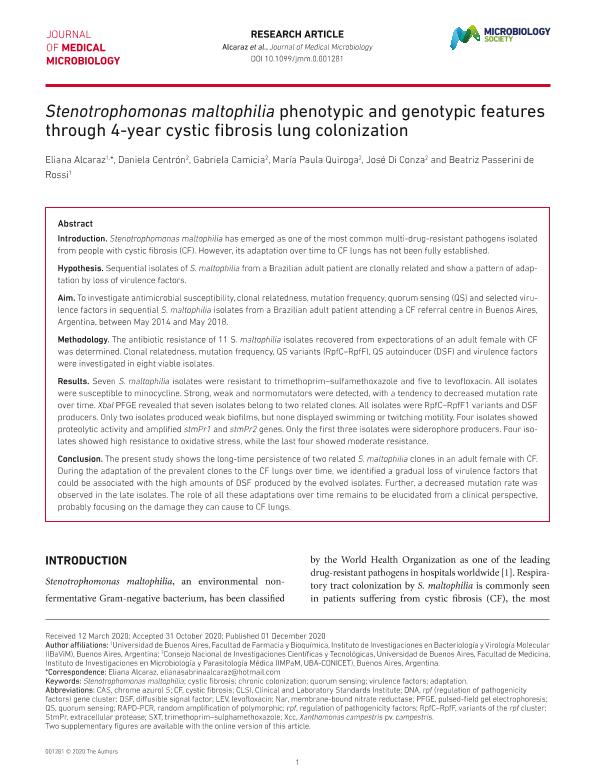Artículo
Stenotrophomonas maltophilia phenotypic and genotypic features through 4-year cystic fibrosis lung colonization
Alcaraz, Eliana; Centron, Daniela ; Camicia, Gabriela Lorena
; Camicia, Gabriela Lorena ; Quiroga, María Paula
; Quiroga, María Paula ; Di Conza, José Alejandro
; Di Conza, José Alejandro ; Passerini de Rossi, Beatriz Noemi
; Passerini de Rossi, Beatriz Noemi
 ; Camicia, Gabriela Lorena
; Camicia, Gabriela Lorena ; Quiroga, María Paula
; Quiroga, María Paula ; Di Conza, José Alejandro
; Di Conza, José Alejandro ; Passerini de Rossi, Beatriz Noemi
; Passerini de Rossi, Beatriz Noemi
Fecha de publicación:
12/2020
Editorial:
Society for General Microbiology
Revista:
Journal of Medical Microbiology
ISSN:
0022-2615
Idioma:
Inglés
Tipo de recurso:
Artículo publicado
Clasificación temática:
Resumen
Introduction. Stenotrophomonas maltophilia has emerged as one of the most common multi-drug-resistant pathogens isolated from people with cystic fibrosis (CF). However, its adaptation over time to CF lungs has not been fully established. Hypothesis. Sequential isolates of S. maltophilia from a Brazilian adult patient are clonally related and show a pattern of adaptation by loss of virulence factors. Aim. To investigate antimicrobial susceptibility, clonal relatedness, mutation frequency, quorum sensing (QS) and selected virulence factors in sequential S. maltophilia isolates from a Brazilian adult patient attending a CF referral centre in Buenos Aires, Argentina, between May 2014 and May 2018. Methodology. The antibiotic resistance of 11 S. maltophilia isolates recovered from expectorations of an adult female with CF was determined. Clonal relatedness, mutation frequency, QS variants (RpfC-RpfF), QS autoinducer (DSF) and virulence factors were investigated in eight viable isolates. Results. Seven S. maltophilia isolates were resistant to trimethoprim-sulfamethoxazole and five to levofloxacin. All isolates were susceptible to minocycline. Strong, weak and normomutators were detected, with a tendency to decreased mutation rate over time. XbaI PFGE revealed that seven isolates belong to two related clones. All isolates were RpfC-RpfF1 variants and DSF producers. Only two isolates produced weak biofilms, but none displayed swimming or twitching motility. Four isolates showed proteolytic activity and amplified stmPr1 and stmPr2 genes. Only the first three isolates were siderophore producers. Four isolates showed high resistance to oxidative stress, while the last four showed moderate resistance. Conclusion. The present study shows the long-time persistence of two related S. maltophilia clones in an adult female with CF. During the adaptation of the prevalent clones to the CF lungs over time, we identified a gradual loss of virulence factors that could be associated with the high amounts of DSF produced by the evolved isolates. Further, a decreased mutation rate was observed in the late isolates. The role of all these adaptations over time remains to be elucidated from a clinical perspective, probably focusing on the damage they can cause to CF lungs.
Archivos asociados
Licencia
Identificadores
Colecciones
Articulos(OCA HOUSSAY)
Articulos de OFICINA DE COORDINACION ADMINISTRATIVA HOUSSAY
Articulos de OFICINA DE COORDINACION ADMINISTRATIVA HOUSSAY
Citación
Alcaraz, Eliana; Centron, Daniela; Camicia, Gabriela Lorena; Quiroga, María Paula; Di Conza, José Alejandro; et al.; Stenotrophomonas maltophilia phenotypic and genotypic features through 4-year cystic fibrosis lung colonization; Society for General Microbiology; Journal of Medical Microbiology; 70; 1; 12-2020; 1-12
Compartir
Altmétricas



